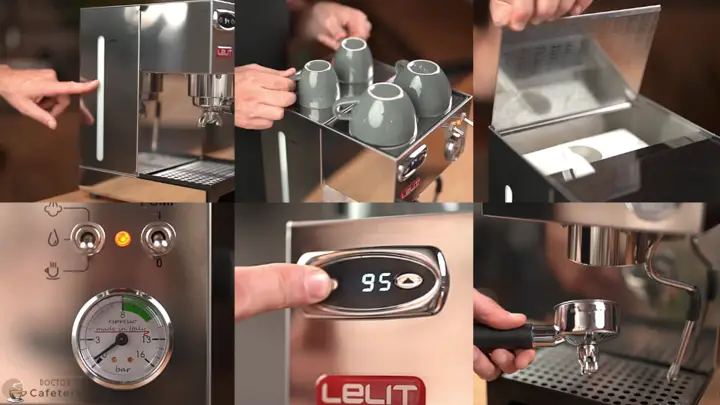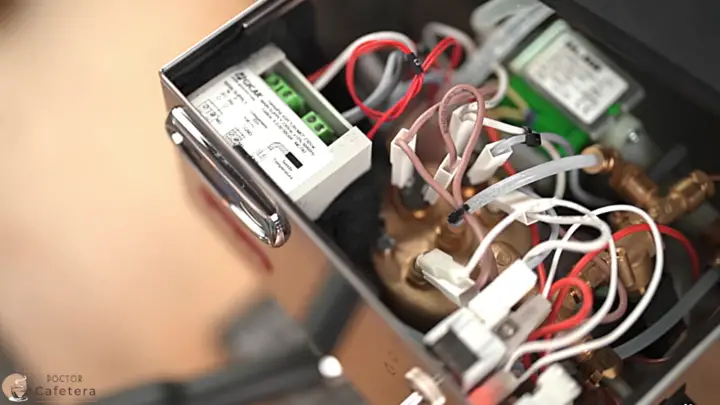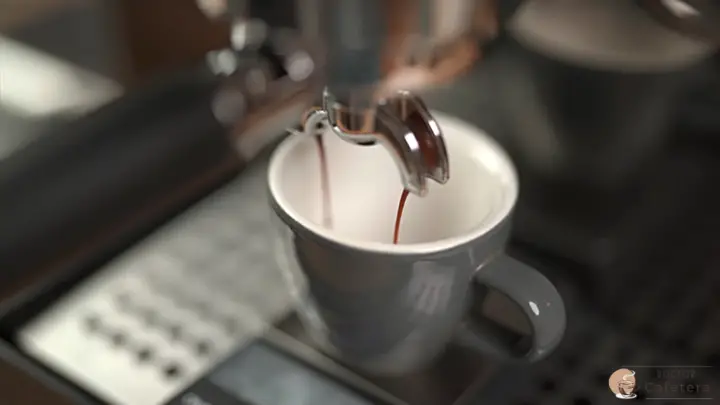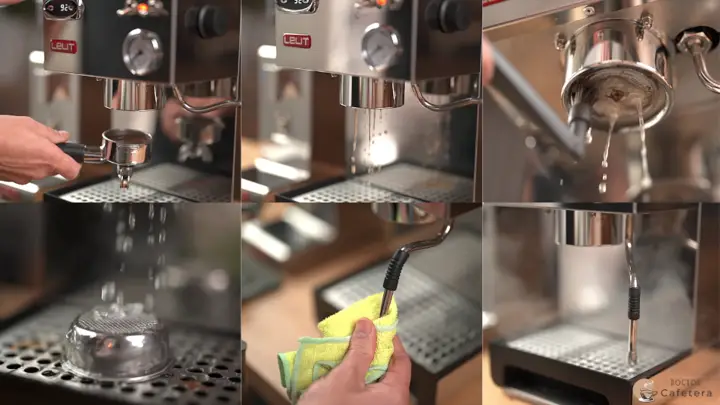I welcome you to this new article, where I bring you a full review of this small but great home espresso machine, the Lelit Anna PID. I have a lot to tell you, so stay tuned because I will give you all the details here.
General features of the Lelit Anna PID
It has an almost entirely polished stainless steel body which gives it good durability and maintenance, the only thing we see plastic is the bottom of the drip trays and the handle of the portafilter.
Everything feels very sturdy and professional for an entry-level machine, it feels very good and is very good quality, and this is something that Lelit excels at by manufacturing these machines directly in Italy. It is very small, about 34 centimeters high, 23 centimeters wide, 26.5 deep, and weighs about 7 kilos.
External components of the Lelit Anna PID
On the side, we have a window to the water tank to know when to refill it; on the top, we have access to it and in front of the area to place cups and keep them warm. On the front, we have the switches for its operation, either for coffee, water, or steam, and next to it, the pump ignition.
Below is the pressure gauge that shows the extraction pressure and the digital thermostat where we can see the water temperature and modify it. Below it, we have the multidirectional steam wand with a dual purpose, to texturize the milk and to deliver hot water for the beverages.
Next to it is the machine group, with its shower and the 57-millimeter filter holder with a double spout that comes with three baskets.
Lelit Anna PID internal components
If we open the machine, we can see what I mean when I talk about Lelit quality. These small domestic machines have commercial grade; they are made with the best materials and technologies as in the machines we see in gastronomic stores, but in a smaller size, everything is repairable, which is very important.
Mainly, we see a total 8.5 ounces brass boiler for fast heating, polymer tubing, and an overpressure valve. It is very important to note in a basic machine like this; it has a three-way solenoid valve.
This valve relieves the pressure after extraction, which is key for cleaning. It makes it possible to keep a coffee pod without water so that it can be easily removed, but it also allows us to clean it with chemicals that pass through the group, as we see in professional machines.
It has a bulky 2.7-liter water tank, which is not often seen in such small machines; we can take it out to fill it by removing the silicone hoses, and if you don’t have a water filter at home, I recommend buying the Lelit ones that connect directly to the hose and are deposited inside the tank.
Water is very important, both for preparing coffee and for the care and maintenance of your machine, so I recommend filtered water. You can even design the water components yourself, as I show you in one of my articles; take a look at it so you can do it at home.
How the Lelit Anna PID works
I will start by showing you how to prepare a coffee in this machine, so you can understand much better the functions it has. Let’s go step by step as if we just received this coffee maker and want to turn it on for the first time.
How to prepare espresso with the Lelit Anna PID
- First, we must fill the tank to the line indicating the maximum.
- We plug the machine into the mains, place the larger basket in the filter holder and insert it into the machine’s group so that it heats up.
- We turn on the machine with the switch on the back and see the light come on.
- Now, we will fill the boiler with water (we will do this only when we turn on the machine for the first time). To do this, we open the steam knob, position the switch in the coffee position and turn the pump on by turning the switch up. In a few seconds, we will see how water starts to come out of the steamer, then we turn off the pump and close the knob, filling the boiler.
- Then we will let the water heat up and reach the desired temperature. It comes from the factory at about 203 degrees Fahrenheit, so you can modify it according to the coffee you are using; as I use a medium roast coffee, I set it to 198 degrees Fahrenheit.
- This is super easy to do, we press the button on the left, and on the screen, we see how it goes into program mode, and with the right button, we go up or down with the left button to reach the temperature we want, we stop pressing, and that’s it. Now the water will heat up, in this case to 198 degrees Fahrenheit.
- We leave the switch in coffee mode, and we will see that the temperature is reached very quickly, in about five minutes, but I recommend waiting at least 15 to 20 minutes when it is turned on; after being turned off for a while, so that everything is as hot as possible and thus obtain a better extraction.
- To grind the coffee, I used the Fred grinder, an excellent companion for this machine; remember that the grinder is fundamental when preparing coffee. Even if you have an excellent machine like the Anna, if you do not have a good grinder that produces a good quality grind, you will not be able to get all the juice out of the coffee maker, developing all its potential, and the coffees will not be delicious. So I highly recommend Fred as a first option.
- We will weigh about 17 grams of coffee in the portafilter and compact it with the tamper (you can use the accessories that come with the Anna, but later I will tell you what you can add to improve the experience). We place the portafilter in the group of the machine.
- We place the cup with the scale on the drip tray, tare it to zero and turn on the pump with the switch, activating the timer on the scale.
- We see how the pressure rises on the pressure gauge and indicates the ideal range for espresso in green. When we have the desired cup weight, about 32 grams, we turn off the pump and have a delicious espresso.
The espresso recipe will depend on the coffee you have, but the truth is that I have enjoyed the espressos that Anna produces. The pressure gauge is very good at guiding us with the calibration of the grind; if we see that it does not reach the green range, it is because we have the grind too coarse or little coffee in the basket, and if on the contrary, it goes over the range is that you have the grind too fine.
Anna has a single boiler with a dual purpose; it is the same boiler that heats the water for the extraction of coffee as for the steam for the milk that needs higher temperatures. So we must do one first and then the other so that this temperature is modified.
How to steam milk with Lelit Ana PID
If we want to prepare a drink with milk, after preparing the espresso, we have to place the switch upwards in steam mode, which starts to heat the water in the boiler to a high temperature to generate steam around about 266 degrees Fahrenheit. Thanks to the power of the machine, this happens quite fast, compared to other entry-level machines on the market, about one minute, depending on some variables.
Once the pilot light comes on, it indicates that we can start using it as follows:
- First, we must expel some steam to discard condensation or water on the rod. To do this, we open and close the steam knob.
- Then, we texturize the milk normally. Anna has a single-hole steamer, which makes the process quite slow and helps beginners understand the technique and pay attention to each texturizing step. So that’s why I highly recommend it for those who want to learn how to make Latte Art.
- Once the milk is ready, we close the knob, wait until no more steam is expelled, and remove the pitcher.
- Clean well with a damp cloth and purge to remove any remaining milk.
- It produces an excellent result, silky milk-like paint with lots of shine, allowing you to practice all the Latte Art figures your heart desires. A lot of capacity in such a small machine.
- A very important step, after having used the steam, we must switch to water mode by lowering the switch to the middle position, opening the steam knob, and turning on the pump. With this, we see steam coming out of the wand until a steady stream of water starts to come out.
- Now we turn off the pump, close the knob, and are ready to lower the switch to the coffee position to continue using the machine. This step removes the rest of the steam and refills the boiler with water from the tank. This happens to all single boiler dual purpose machines, which can be a little annoying at first, but it is a simple step that becomes routine.
Accessories I recommend adding to the Lelit Anna PID
Some things I recommend adding to this machine to take it to another level, with a small investment, are:
- First, a 57-millimeter steel tamper that, being heavy, is going to give you much more consistency than the plastic one, being able to compact the coffee in a more level way.
- A 57 millimeters precision basket, the same applies to all espresso machines. Changing the stock basket with a precision basket is the best option; the espresso extraction changes drastically for the better.
- Essential for maintenance and cleaning, and the truth is that I don’t know why Lelit doesn’t include it in this model; it is a blind basket to be able to put the chemicals in it and do the back flash cleaning. Otherwise, you can also get one of those universal rubber plugs.
- For the cleaning, a group brush, and the products for this, of course.
- And a plus would also be a bottomless filter holder to see how the extraction comes out, which is the best way to learn how to identify errors.
Lelit Anna PID maintenance and cleaning
Let’s continue with the maintenance and cleaning of this machine. After each use, I always recommend purging water through the group and brushing it, cleaning the filter holder, removing the basket, and washing it with hot water. And after using the steam wand, wipe it with a damp cloth and always purge.
Depending on how you use it since it is a domestic machine, I recommend deep cleaning with chemicals once or twice a week, as follows:
- We place a teaspoon of the espresso machine cleaner in the blind basket of the filter holder or, if you have a cap, directly inside the filter holder.
- Place the filter holder in the machine group.
- With the switch in coffee mode, turn on the pump and let the water run for about 10 seconds.
- Turn off the pump and wait another 10 seconds. We repeat this step five times, turning the pump on for 10 seconds, turning it off, waiting another 10 seconds, and so on.
- After five repetitions of this on and off, we turn the pump on, let the waterfall, and rinse the filter holder, removing the remains of the chemical.
- Now, we will repeat the pump turning on and off, but this time without the chemical.
- We place the empty filter holder, and again we activate 10 seconds, turn it off, wait 10 seconds, and turn it on again. Again about five times.
- And ready, with this, we have an impeccable machine inside and out.
NOTE: The only thing to remember is that it is recommended that the first coffee you take out, after doing this deep cleaning, you discard it in case there is any chemical residue.
Conclusion
Finally, I have covered everything you need to know about the Lelit Anna PID. A machine that I highly recommend for anyone who wants to take the first step into the prosumer world. For those who want to prepare drinks like the best coffee shops, but at home. You can obtain delicious espressos and professionally texturized milk.
It seems to me to be the complete entry-level machine for its price and a more basic Lelit model; it comes with all the requirements to prepare excellent high-quality coffee.
There are no pressurized filters, as in other machines, which already show the target public. And we see features of much more expensive machines, all in a very small format.





